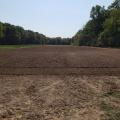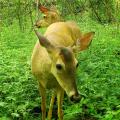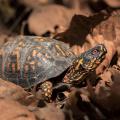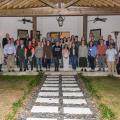Food Plots
Planting wildlife food plots is a common practice, especially for white-tailed deer. Many landowners or club members believe that a properly managed habitat and deer herd includes planted food plots. While the contribution of supplemental plantings to deer management should not be overlooked, more benefit can be realized through manipulation of native habitat. Practices such as well-timed prescribed burning of pine forests or proper timber harvesting techniques will provide abundant, high-quality forage and cover for deer at little or no cost to the landowner.
Consistently productive food plots require careful thought and planning before they are implemented. Factors to consider include the following.
- Location:
Plots should be located on fertile soils with adequate drainage. Cover should be located nearby or scattered across the plot. Food plots should not be established near a public road or waterway due to the increased possibility of poaching.
- Size:
Plot size and shape may vary with local conditions, but to provide adequate sunlight to meet forage production requirements generally should not be less than one acre.
- Spacing:
Plots should be scattered over the entire property if possible. It is more beneficial to establish 10 plots 2 acres in size than to have a single 20acre field. Cost may dictate total acreage planted.
- Soil Testing:
To ensure productive food plots conduct soil tests for fertilization and lime requirements. The local county agent (MSU-Extension Service office) can provide information on soil sample collection and where to send them for analysis. Be sure list the potential crops to be grown when sending in soil samples for testing.
- Planting:
Be sure to select a plant species or combination of species that will grow on the particular soil type and site that you have. If unsure, ask the county agent, wildlife biologist, or local seed supplier. Proper seedbed preparation will increase germination and yield more productive food plots. Plant crops at the prescribed seeding rate and during the proper planting season. It is critical that legume seeds (clovers, peas, beans) be inoculated with nitrogen fixing bacteria before planting.
Food Plots Publications
Publications
News
RAYMOND, Miss. -- Frustration is mounting for deer hunters across Mississippi whose cool-season food plots died or never got planted because of drought conditions. Although it’s November, hunters still have time to replant.
RAYMOND, Miss. -- An urban wildlife specialist and a group of trained volunteers with the Mississippi State University Extension Service have been tracking wildlife in the Jackson metro area for three years to better understand how gentrification impacts urban wildlife populations.
Their work is part of an unprecedented nationwide study led by Lincoln Park Zoo’s Urban Wildlife Institute and recently published in the journal “Proceedings of the National Academy of Sciences,” or PNAS.
Snapping turtles and box turtles. Very different in many ways.
Success Stories
In late February, Mississippi State University hosted the 2024 National Floriculture Forum, an annual conference held at different locations around the country.
A Smithsonian Institution exhibit about rural communities continues its journey in public libraries across Mississippi.
Stafford Shurden’s weather station is ideal for monitoring conditions on his row crop farm, but he uses it even more during hunting season than growing season.











